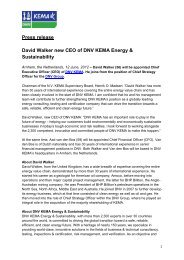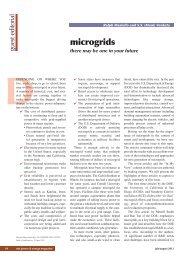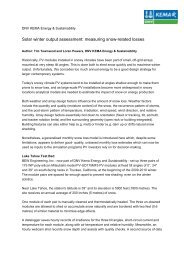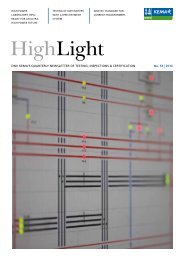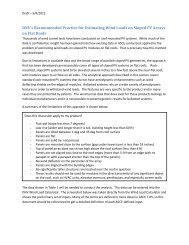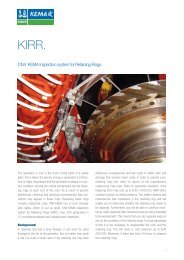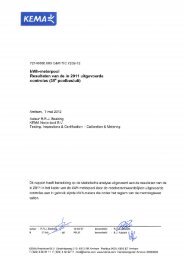Diagnostics and testing of rotating electrical machines - DNV Kema
Diagnostics and testing of rotating electrical machines - DNV Kema
Diagnostics and testing of rotating electrical machines - DNV Kema
Create successful ePaper yourself
Turn your PDF publications into a flip-book with our unique Google optimized e-Paper software.
04<br />
ENERGY<br />
Non-destructive <strong>testing</strong> & plant diagnostics<br />
■■<br />
Quality control: checking the manufacturing process by<br />
inspection <strong>and</strong> <strong>testing</strong>. Various components are tested during<br />
manufacture. The manufacturer’s progress, quality assurance<br />
measures <strong>and</strong> results are also assessed.<br />
■■<br />
Tests (FAT <strong>and</strong> SAT): <strong>DNV</strong> KEMA performs its own tests or<br />
witnesses <strong>testing</strong> by others to check conformance to the design<br />
specifications. During factory acceptance <strong>testing</strong> (FAT), type<br />
tests <strong>and</strong> routine tests are performed to verify that the <strong>rotating</strong><br />
machine has been built in accordance with the specifications.<br />
During site acceptance <strong>testing</strong> (SAT), the quality <strong>of</strong> the<br />
delivered installation is checked to ascertain whether it fullfils<br />
the applicable requirements.<br />
■■<br />
Commissioning: once all the separate components have been<br />
installed <strong>and</strong> tested, <strong>DNV</strong> KEMA will witness <strong>and</strong> assess <strong>testing</strong><br />
<strong>of</strong> the complete installation under various normal <strong>and</strong>/or<br />
extreme operating scenarios, defined by consultation.<br />
From design to decommissioning<br />
The life cycle <strong>of</strong> any machine may be divided into the following phases:<br />
■■<br />
Design<br />
■■<br />
Manufacture<br />
■■<br />
Operation<br />
■■<br />
Conservation<br />
■■<br />
Decommissioning<br />
Operations<br />
Our approach to condition assessment <strong>and</strong> residual service life<br />
forecasting has several elements, which together provide an<br />
accurate picture <strong>of</strong> the machine as a whole. First there is the<br />
actual inspection <strong>and</strong> <strong>testing</strong>. These activities are followed by<br />
the interpretation <strong>of</strong> measured data <strong>and</strong> analysis <strong>of</strong> the existing<br />
situation. Interpretation <strong>and</strong> analysis yield an overview <strong>of</strong> the<br />
condition <strong>of</strong> the machine <strong>and</strong> its likely residual service life.<br />
Finally, there is failure analysis. In the event <strong>of</strong> unexpected<br />
problems, destructive <strong>testing</strong> <strong>of</strong> the failed component can be<br />
undertaken to ascertain the cause. As well as providing you<br />
with insight into the condition <strong>and</strong> residual service life <strong>of</strong> your<br />
machinery, we can advise you regarding the most cost-effective<br />
repair, maintenance <strong>and</strong> operating strategy. We can indicate<br />
whether it is best to take a machine out <strong>of</strong> service straight away,<br />
to make provision for replacement, or to continue running the<br />
machine normally. The diagnostic techniques that we use are<br />
selected to minimize the need to dismantle <strong>rotating</strong> machinery.<br />
Dismantling is a costly <strong>and</strong> time-consuming business, which<br />
introduces risk; as such it should be avoided except where<br />
strictly necessary.<br />
<strong>DNV</strong> KEMA uses four primary techniques for condition<br />
assessment <strong>and</strong> residual service life forecasting:<br />
■■<br />
Endoscopy: a visual inspection technique that enables the<br />
examination <strong>of</strong> areas that cannot be viewed with the naked eye<br />
■■<br />
Dielectric <strong>testing</strong>: a technique for assessing the <strong>electrical</strong><br />
insulation <strong>of</strong> <strong>rotating</strong> machinery components






